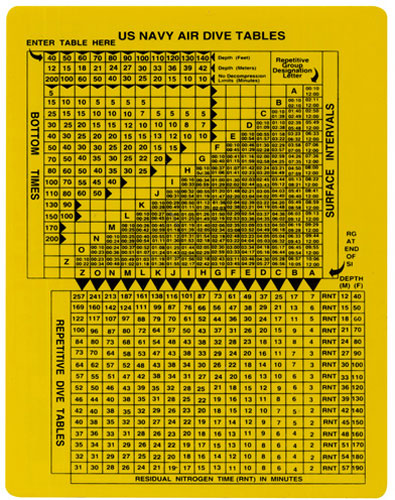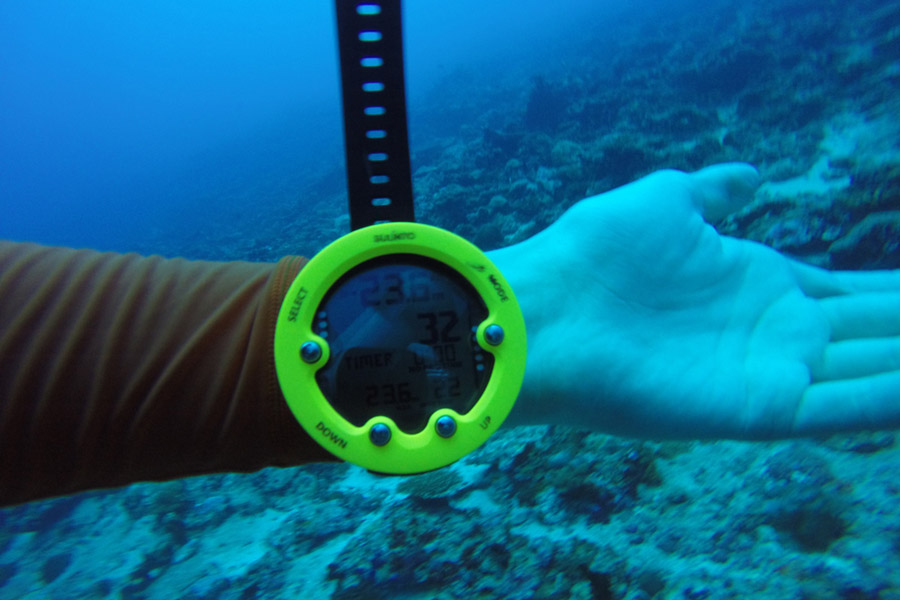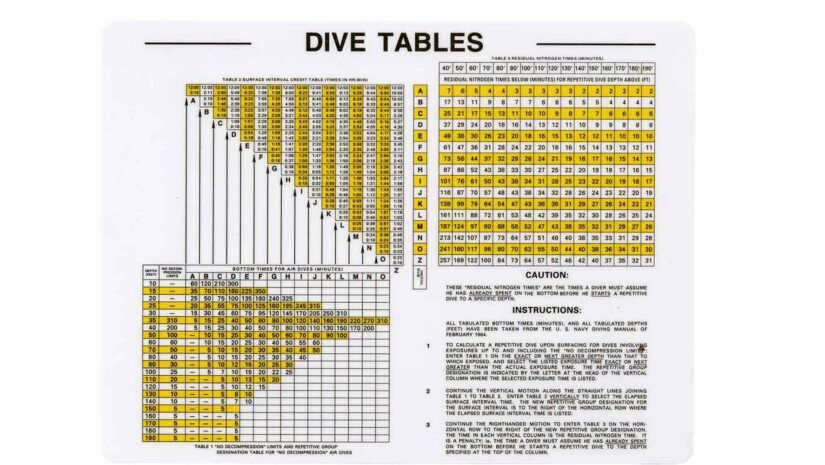Dive tables are one of the things you’ll have to be very familiar with before you can become a certified scuba diver. Knowing your dive tables isn’t a skill that’s paramount these days with the advent of dive computers, but it pays to have a basic understanding of the information that dive tables provide.
Let’s learn more about dive tables and their importance for both new and experienced scuba divers.
What are Dive Tables?

Dive tables (also known as recreational dive planners, dive charts, and decompression tables) were originally created by the US Navy to regulate scuba divers’ underwater time and prevent them from absorbing too much nitrogen, which results in decompression sickness or “the bends.” They are basically charts filled with numbers and letters that refer to water depths and times. These charts are commonly printed on booklets and waterproof plastic cards that divers can bring with them for reference underwater.
Certifying agencies, like the Professional Association of Diving Instructors (PADI) and the National Association of Underwater Instructors (NAUI), have their own versions but they only really differ in format. Standard recreational dive tables from all certifying agencies pretty much assume that you’re diving with standard compressed air (not Nitrox or other gas mixes) and that you won’t be visiting other depths or dive back down after resurfacing.
These guides also assume that the user is diving at sea level or in waters less than a thousand feet, descending at about 60 feet per minute, and resurfacing at 30 feet per minute before slowing down starting at 15 feet. They can be found or sold in various places and are considered must-haves in save-a-dive kits.
The Importance of Dive Tables

People now consider scuba diving to be a safe pursuit despite the many risks associated with swimming at such great depths. This is due to the intensive diver training, standardized safety procedures, and advanced scuba equipment that have made scuba diving both safe and enjoyable.
On the other hand, despite the various advancements, dive tables and modern dive computers cannot eliminate the risk of decompression sickness, though they can greatly minimize the risks. With guidance, you won’t mistakenly ascend too fast and will be able to give your body enough time to safely expel the absorbed nitrogen.
Dive tables serve as a guide for divers to know how long they could stay under at a particular depth, how long surface intervals should be, and how to calculate the amount of residual nitrogen in the blood after a dive. With this information, you can plan your dives and set expectations for yourself (and your dive buddies) ahead of time.
The scuba diving industry has positively progressed with the assistance of traditional dive tables. The rate of decompression has lowered significantly, and decompression sickness is no longer accepted as a given when scuba diving. Tables have also been modified over the years to refine the process and further reduce the risk that scuba divers face.
How are Dive Tables Used?
There’s a reason why dive tables are often taught during scuba diving classes and why certified scuba divers end up forgetting how to use them. If you look at it without anybody teaching you what the columns, numbers, and letters are for, it’s easy to be overwhelmed by the charts. This is usually the case when checking out this PADI dive table (click to enlarge).

Here’s one example from the PADI dive table:
You dive to a depth of 60 feet and stay down for 37 minutes. This puts you in pressure group O. After a surface interval of an hour, you have off-gassed enough nitrogen to move you up to pressure group E. This means that, while there is still residual nitrogen in your blood, it is much less than when you first surfaced.
Now that your hour surface interval has passed, you are going to dive to 40 feet for 30 minutes. This time, not only would you count the amount of nitrogen you will absorb during this 30-minute dive, but also the residual nitrogen left in your blood from the previous dive.
While it sounds complicated, these charts put everything into an easy to read format that can help you plan out your bottom time safely. When diving, your time at the surface is just as important as your time underwater.
For another tutorial on how you can read a dive table, check out this instructional video below:
Dive Tables vs Dive Computers

Dive tables do have their limitations, namely that they’re based on what is referred to as a “square profile”. This assumes that a diver descends to a predetermined depth, spends their entire time at that depth, then makes a direct ascent to the surface. Meanwhile, dive computers, which have been around since the 1980s, constantly adjust your maximum allowed bottom time based on your actual dive profile.
With a dive computer, you might be able to do a dive with a maximum depth to 100 feet (but with much of the dive spent at other depths) for well over an hour, compared to a dive table that would only allow a 20-minute bottom time at 100 feet. Human error is also eliminated, thus making it the preferred tool to allow safer and longer dives.
So why would any diver want to spend time understanding the low-tech dive table? There are a handful of reasons.
For one, dive computers can be expensive, especially if you want a stylish, modern, and durable model. Second, there’s always the risk of your dive computer failing, so having a dive table in your kit can save the day (not to mention, it’s more affordable than having a backup dive computer). Third, it can be harder to operate and understand dive computers as they are all different. And finally, dive tables help you understand the reason behind the numerical results on dive computers.
Dive tables may be one of the most daunting aspects of scuba certification, but don’t be put off by scuba math!
Feeling confused during training? Never be afraid to ask questions about what you’re learning in a scuba class. If you are having any difficulties with dive tables, talk to your instructor. Knowing your dive tables can lead to better diving no matter where technology takes us.


